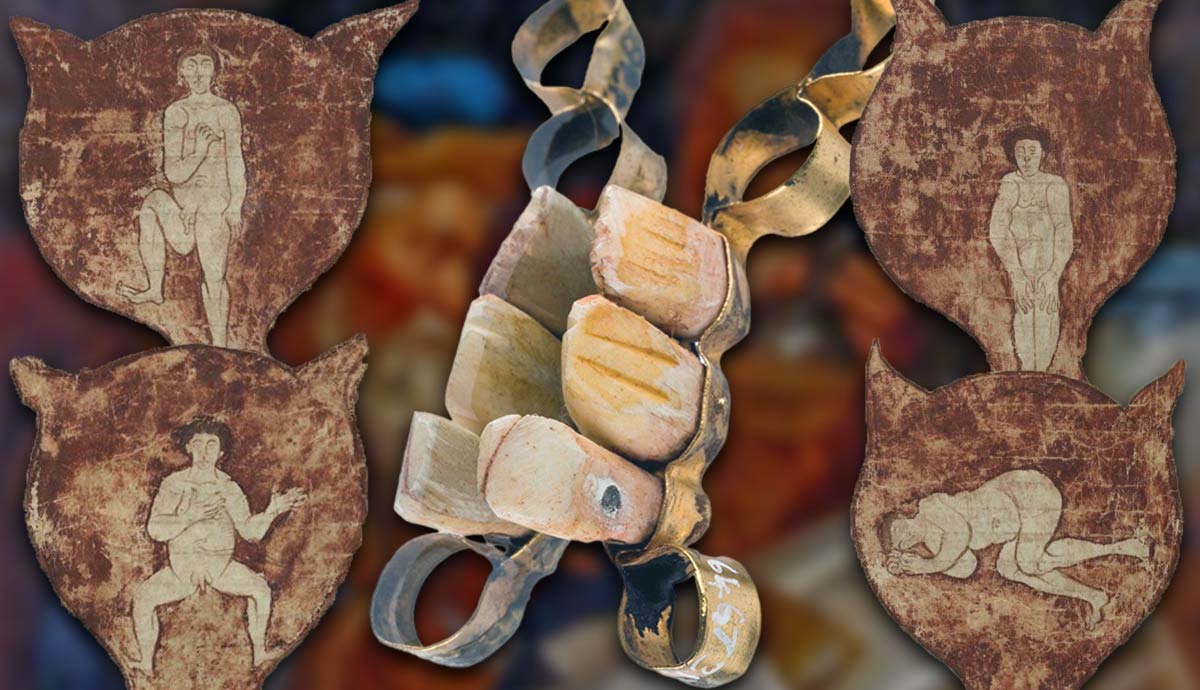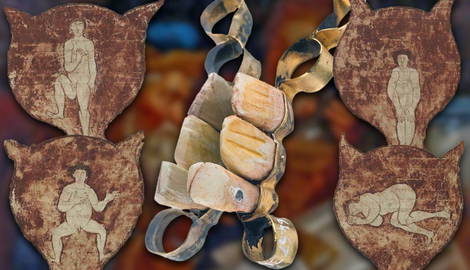
Although the ancient Romans were broadly aware of the importance of cleanliness, in instances where being clean was just not enough to fight through diseases and fractures, they also relied on doctors. Their doctors were self-taught, mainly Greek, and often charlatans. They did what they could with the knowledge they had, a lot of which remained customary practice for centuries. Despite the drawbacks of their time, Roman medicine laid a solid foundation for successors to build upon, and many Roman medical practices are still used today albeit they have been upgraded in various ways.
1. Dental Bridges and Implants

When trying to envision an ancient Roman, one would probably add a few blackened teeth or a hole in the smile. Although this image might be pertinent to some, there were in fact many Romans who had beautiful pearly whites. On the one hand, their diet was mostly void of sugars so their teeth did not rot as much as one would expect (or as ours do today). On the other hand, when dental hygiene failed, the Romans had a solution that they seem to have borrowed from the Etruscans — dental bridges, many of which have been found on Roman skeletons.
Although tooth extraction was the most common “therapy” for rotten teeth, some Romans who could afford it, were able to buy new ones. To show how common these interventions were, it is worth mentioning that the Law of the Twelve Tables (a list of laws created in the 5th century BCE), forbids the extraction of gold used to fasten teeth, from the mouth of the deceased! The teeth that filled the metal frames were either from animals or were recycled human teeth. There has also been talk of dental implants among the Romans, but the only supposed piece of evidence for this is disputed. A cast iron tooth was found in a soldier in a Gallo-Roman necropolis dating from the 2nd century CE, but even if it does serve as an example of a successful dental implant, it is an exception rather than the rule.
2. Plastic Surgery

Even though wound suturing belongs to the realm of plastic surgery, Roman surgeons did carry it out extensively. There are also many other interesting interventions they performed in order to preserve (and sometimes improve) the original shape of their patients’ faces. Rhinoplasties, i.e., nasal reconstructions were among the most common.
The Edwin Smith Papyrus from 2nd millennium BCE Egypt gives detailed explanations on how to approach mending a broken nose, as does the Greek doctor Hippocrates. Among the Romans, Galen and Celsus offer some instructions on repairing the nose, mouth, and ears. Celsus, for example, encourages tempering for nostrils, ears, and lips when damaged by mutilation, but only to a certain extent, as larger changes might result in an even uglier appearance. The objects of such operations were mostly gladiators and soldiers. Celsus warns surgeons not to deal with the old and sickly for these interventions, as their wounds will not heal quickly or properly.
The first images that usually come to mind concerning plastic surgery are corrective surgeries carried out for beautification — and these were also present in ancient Rome! Celsus commented on ear-jobs for those whose ears had stretched from wearing heavy earrings, and skin grafts existed in ancient Rome, although they were later forgotten up until the 19th century. One purpose of skin grafting, described by Galen, was foreskin reconstruction, in order to help Jewish men resemble Romans.
3. Amber for Babies

Modern-day babies are often adorned with amber necklaces in hopes of helping them with their teething, and the Romans, as Pliny testifies in his Natural History, used the same material to benefit their newborns in general — although not for teething specifically. Rather, they used different sorts of amber talismans and recommended them for uses other than baby protection.
Pliny quotes Callistratus as an authority on amber and says that he recommended the use of amber as an amulet on a necklace, or as a powder for various diseases, including ear, stomach, eye problems, and fever. Galen gives recipes for lozenges containing amber, to be used for cough, dysentery, flatulency, bowel problems, etc. Among the other benefits of amber, Galen discusses diseases of the mouth. Other medical text authors, like Celsus for example, completely omit amber when speaking of drugs.
There are several terms denoting amber which some ancient authors use interchangeably. The logical explanation for this is that amber-containing drugs were introduced into medical textbooks from folk remedies, and different terms were used in different areas of the Empire, hence the array of synonyms. Although no lozenges survive today, there are several amber talismans from the Roman period, demonstrating the use of this material. The use of amber for medical or medical-like purposes in modern times, also comes from folklore.
4. Caesarian Section

In use everywhere in modern times, the Caesarian section was not a Roman invention or a popular childbearing method in ancient Rome, nor does it have anything to do with Julius Caesar, besides being eternally bonded with his name. Pliny notes that children born “caesi a matris utero” are called caesones, and he connects this way of being born with the word Caesar but his etymology, in this case, does not seem plausible.
The Lex Regia, later to become the Lex Caesaris (which some say influenced the term for this procedure) explicitly states that a deceased pregnant woman should never be buried with the child inside:
“Negat lex regia mulierem quae praegnans mortua sit, humari, antequam partus ei exciditur: qui contra fecerit spem animantis cum gravida peremisse videtur.”
“The Lex Regia forbids burying a woman having died pregnant, before the offspring is cut out of her; whosoever does otherwise is considered to cause the hope of life to perish with the mother.”
Ancient medical texts make no mention of this birthing method. Known cases of Caesarian sections are all postmortem, and all originate from mythology. Namely, the gods Dionysus and Asclepius were born postmortem, i. e. extracted from the bodies of their dead mothers, and the god Adonis came out of a tree ten months after his mother Myrrha, who had been transformed into a tree by the gods trying to save her from her jealous husband/father. Carrying out this procedure on living mothers does not seem to have been popular, although some modern researchers claim it was done in Jewish communities.

Soranus (1-2nd century CE), describes in his book on gynecology the causes of a difficult labor and he explains the possible positions of the fetus, e.g. feet down, breached baby, etc. — all reasons for a C-section today. Yet he only suggests various positions for the parturient depending on the reason for the difficult labor. He mentions lubrication and oily sitz-baths, and he describes maneuvers for turning the fetus around. Never does he take into consideration the option of cutting open the mother. On the contrary: If the fetus is not responding to manual traction, extraction by hooks or embryotomy is advised only in order to save the mother.
5. Urine Analysis

Uroscopy, or rather uroscopia, as it was known until the 17th century, was a diagnostic tool already in use in ancient Babylon and ancient Egypt. In Greece, the doctor Hippocrates had some fairly correct observations concerning urine sample/disease relations: kidney disease was diagnosed on the basis of bubbles forming on the surface of a urine sample, blood in urine is suggestive of bladder ulceration, sedimentation increases with fever, and a sweet taste to the urine is indicative of diabetes. It was Galen who upgraded Hippocrates’ theories, beginning with a more accurate description of the origins of urine, and even more specific diagnoses based on urine samples.
Some of the medical practices mentioned above were at their peak in ancient times and then neglected in the Middle Ages, but when it comes to uroscopy, the practice overdeveloped leading to almost every disease being diagnosed on the basis of urine samples. The word –scopia in uroscopia suggests looking (from the Greek σκοπέω “to look at”), but doctors actually also assessed samples by smelling and even tasting the urine.
Needless to say, urine analysis today is a valuable aid to diagnosticians, albeit it is not the only tool for the assessment of a patient’s condition. As for tasting urine, this is also not unheard of in modern times, be it for the purpose of rehydration in difficult circumstances, or among believers that urine can be used as a cure for various diseases (a point also made by some in ancient times). The ancient Romans were also famous for their urine tax, and aside from using it to wash clothes, urine seems to have been used as toothpaste.

Ancient Roman medicine was a combination of folk medicine and inherited knowledge from their neighbors. Built upon by Roman physicians, it also had many spiritual features. The prohibition against cadaver examinations slowed down its development but nevertheless, Roman doctors, even without academic medical training, had many means of helping their patients. They had developed surgical instruments, drug recipes, and various procedures for assisting the ill. Many of the procedures they used were studied in further depth over time, and they have advanced thanks to new resources and the development of science. However, the ideas were already there more than 2,000 years ago.









